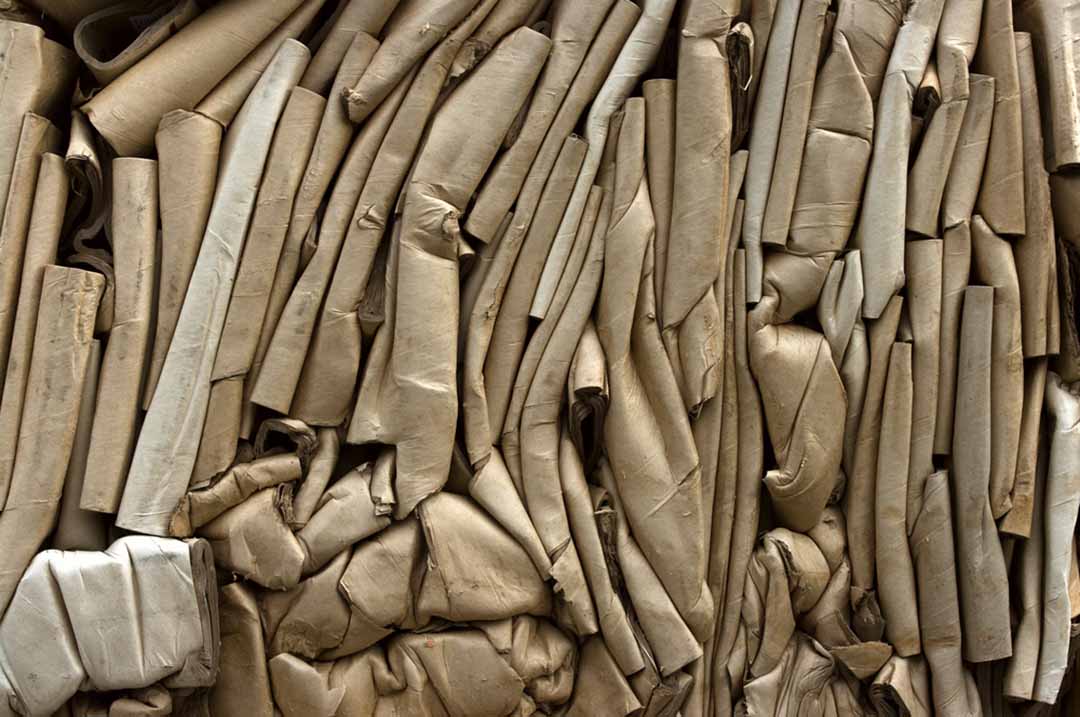
Paper markets are a mixed bag, with some producers completing or nearing completion on new mills and others wrestling with flagging sales. | Huguette Roe/Shutterstock
Cascades is very close to reopening a Virginia mill that has gone through a containerboard conversion, and Domtar has completed a $350 million project in Tennessee.
Facing market headwinds in pricing, transportation costs and softening demand, several recycled fiber end users shared quarterly results recently, with details on major mill projects.
Below are updates from Cascades, Domtar and Greif.
Bear Island mill conversion close to complete
Quebec-based Cascades said in its Feb. 23 fourth-quarter earnings presentation that its Bear Island containerboard conversion project is on track to start up by the end of March. It will produce 100% recycled linerboard. Mario Plourde, president and CEO, said in an earnings call that 100% of its production volume is secured for this year and 75% is secured for 2024 and 2025. It’s forecasting a production of 235,000 short tons in 2023.
The facility, located in Ashland, Va., was initially slated to come on-line up by the fourth quarter of 2022, but was delayed. It was also originally projected to cost around $380 million, but cost increases put the final figure closer to between $515 million and $525 million, with $396 million invested in the project so far, Plourde said.
Overall, Cascades reported $1.13 billion in Q4 sales, down from $1.17 billion from the previous quarter but up from $1.02 billion year over year. Fourth-quarter earnings before interest, taxes, depreciation and amortization (EBITDA) were $116 million.
The Packaging Products division and the Tissue Papers division both reported higher year-over-year sales, Plourde said, increasing to $567 million and $721 million, increases of 19% and 13%, respectively.
Cascades posted $4.46 billion in full-year sales, Plourde said, compared with $3.95 billion in 2021.
Plourde said during the investor call that operations have “faced more than $475 million of production, raw material, freight and energy cost headwinds within the span of the calendar year 2022 alone, and our teams have done an excellent job at executing multiple countermeasures.”
“These have taken longer in our Tissue Papers segment, where price rebalancing takes time to be realized, but we are encouraged by the progress being made and expect continued benefits to be generated from operational and profitability initiatives across our operations,” he added.
Plourde also said he expects OCC market conditions to normalize but does “not expect this to lead to any material pricing movement in the short term.”
Tennessee containerboard mill comes on-line
In Kingsport, Tenn., Domtar brought its $350 million recycled containerboard mill on-line in January, producing its first 100% recycled roll.
The South Carolina-based company spent two years converting an uncoated freesheet paper mill into a 100% recycled packaging facility. The mill will convert about 660,000 tons of recovered fiber annually into recycled performance linerboard and corrugated medium.
Mike Butler, senior sales director, said “we aren’t interested in being just another containerboard supplier.”
“We want to become North America’s premium producer with deep and lasting partnerships with independent corrugators,” he said.
Domtar produces approximately 3.4 million metric tons of softwood and fluff pulp at 11 pulp and paper mills, according to SEC filings, with an annual paper production capacity of approximately 2.4 million tons of uncoated freesheet paper.
In 2022 it saw sales increase by $909 million, or 25%, from 2021. Paper and pulp sales specifically were up $366 million from 2021, coming in at $527 million in 2022.
The pulp and paper operations also had $67 million of conversion costs for the Kingsport mill conversion in 2022, compared to $30 million in 2021, the filings noted.
Greif sees lower Q1 2023 sales
Greif noted in an investor call that its first quarter of sales of paper packaging declined by about $50 million due to lower mill and converting volumes despite year-over-year pricing tailwinds.
It also closed on acquisition of Lee Container in December for $302 million and announced a majority stake of 80% in Centurion Container for $145 million.
Year over year, Greif’s Global Industrial Packaging sector saw a decline in net sales to $705.8 million, down from $949.1 in Q1 2022. Its adjusted EBITDA dropped from $114.2 million in 2022 to $71.8 million in 2023.
The paper and packaging division also saw an overall decrease year over year, with net sales falling from $610.0 million in Q1 2022 to $560.2 million in Q1 2023. However, EBITDA increased in 2023 to $90.7 million, from $80.5 million.
Overall, the company had a decrease in net sales from about $1.6 billion in Q1 2022 to about $1.3 billion in Q1 2023, and adjusted EBITDA fell from $196.8 million to $164.5 million.
Larry Hilsheimer, executive vice president and chief financial officer, noted in the investor call that he wanted to “reframe things with a broader look at history to highlight the improvements we’ve made in the business model and our earnings power.”
“Looking back at our Investor Day last year, we presented a recession downside case of $600 million to $700 million of EBITDA, and $260 million to $320 million of free cash flow. The volume trends we’re seeing at present are significantly worse than those scenarios, and our earnings and cash flow outlook is better,” he said.
He added that “we have simply raised the bar and performance at Greif by taking action to right-size our costs by maintaining our strict pricing discipline in the marketplace, and by using our balance sheet to continue to grow the business.”
More stories about markets
- Weak bale pricing compounds hauler headwinds
- Novelis posts steady Q2 amid tariffs, fire recovery
- West Coast ports expect slowdown in container shipments